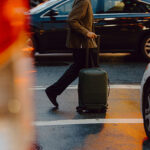Wedding days are one of the most special days of a married couple’s life. That’s why hiring a professional photographer to capture the day is usually top of their list. Lindsay Coulter’s husband trailed her as she photographed a full wedding day, from getting ready to the reception. Here are some of the tips and tricks Lindsay shared to ace your first wedding day shoot!
Pack A Variety of Equipment
When shooting a wedding, you’re likely to be taking many types of shots, from full-body to close-up portraits and details. That’s why Lindsay always packs various lenses, as well as multiple cameras and some additional indoor lighting equipment. On this particular wedding day shoot, she’s packed her mirrorless 4K Canon R6 camera.
Plus, her old-school Canon AE-1 film camera for some vintage shots. Her preferred lens is her Canon RF 35mm F1.8, as it’s not as limited as her 50mm. She can take both candids and portraits with the 35mm, as long as they are not too close-up, as the image may distort. She’s also packed her Samyang 85mm F1.4, Canon RF 50mm F1.8, and Canon RF 16mm f2.8 lens in case. Additionally, her Godox V860 II flash for lighting up her getting-ready photos indoors flatteringly.
Be Prepared
Lindsay likes to come prepared for every shoot, particularly weddings. She always shows up at the door or suite exactly 10-15 minutes early. Otherwise, the wedding guests tend to worry she isn’t going to arrive. Who can blame them? Weddings are generally high-stress occasions where any number of things could go wrong and spoil the day (and mood).
… I’m going to tell you one thing that I think is very important. If you don’t show up at least ten minutes early for a wedding, the couple will think that you’re not coming. It’s just a fact…
Being there early eases the tension, allowing you to take those all-important details shots before the party gets ready. Of the dress, shoes, bouquet, wedding bands, and any other special wedding accessories, for example.
Then, the bridal party and groomsmen getting ready afterward, stress-free. Two essentials Lindsay suggests bringing with are tools to hang dress and frame items. And a checklist listing all the poses and images you’d like to capture.
Know Your Wedding Shot Compositions
To compile a wedding photography checklist, you need to know which poses to take. Think about the various compositions beforehand, and run them by the bride and groom, too. They will likely have a general idea of the types of poses they prefer or want to leave out.
Some examples of typical wedding events, scenarios, and poses to photograph include:
- Getting ready – the bride and groom, mom and dad, and getting ready details.
- Couple’s pre-wedding photos – the first look and posing together at the ceremony venue.
- Wedding party photos – guests, pre-ceremony interaction, and arrivals.
- Venue & arrivals – venue details, wedding party arrival, and guests being seated.
- The ceremony – coming down the aisle, vows, and post-vow kiss.
- Family photos – after-ceremony posed portraits with bride, groom, and family.
- Post-ceremony couples photos – creative couple shoots, trash the dress, or dress/outfit change.
- Reception photos – party, dinner, drinks, dancing, and after-ceremony festivities.
Know How to Pose Your Subjects
When taking photographs of people — specifically at a wedding — it’s important to know how to guide poses. Unlike models, most regular couples and wedding guests have little to no knowledge of how to pose naturally. Or which poses are most flattering or show off their best side.
As such, it’s important to both train your eye and practice working on your communication and posing request mannerisms.
Many subjects are shy and afraid of getting their photo taken. So being warm, positive, and encouraging, as well as giving compliments, is highly recommended. You can also share your best snaps in between shots to build the couple’s and wedding guests’ confidence.
Use Presets
Presets are an excellent way to get that perfect look for wedding photos. There are so many different ones available online — for free or paid. You can even create custom presets to apply to your photos yourself in Adobe Lightroom or other similar photo editing software.
Playing around with complimentary tones, black & white, pastel, and glowy sunset shades is sure to produce results. You should match the image shades to the event details and theme; be it an autumnal wedding or a bright spring affair.
Conclusion
Photographing weddings isn’t just nerve-wracking for brides, grooms, and wedding guests but for photographers, as well. Yes, wedding shoots can be very lucrative. But also quite social, being both physically and emotionally demanding, as following Lindsay on this shoot clearly illustrates. They also require plenty of forward planning and a diverse skill set and photography gear to perfectly capture the day.
Like This Article?
Don't Miss The Next One!
Join over 100,000 photographers of all experience levels who receive our free photography tips and articles to stay current:





